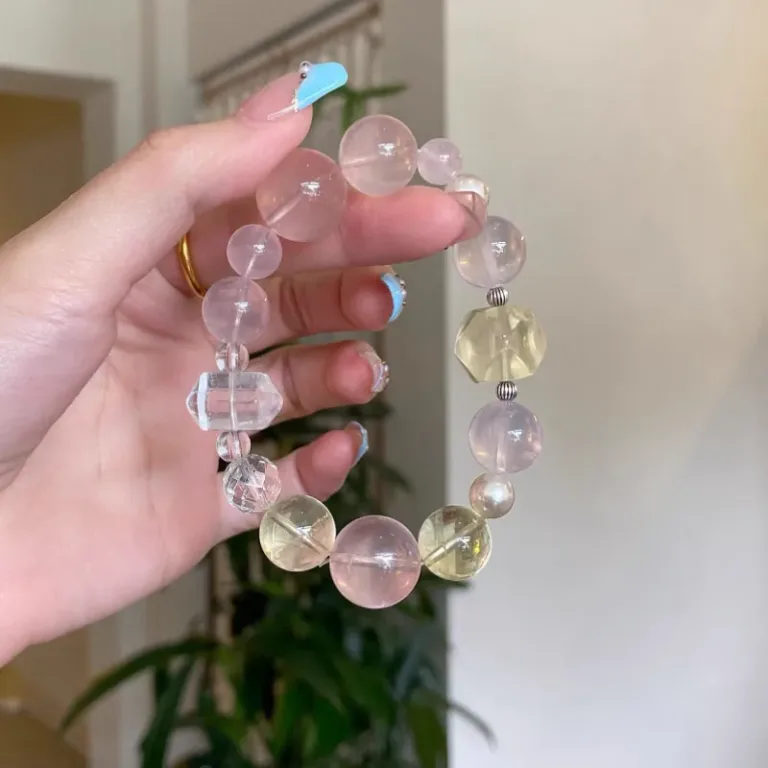In the mineral kingdom, there is a gem that has conquered human civilization for thousands of years with its mysterious purple hue – Amethyst, the most respected member of the quartz family. From ancient Greek temples to medieval bishops’ rings, from oriental feng shui formations to modern energy therapy, amethyst has always exuded its unique charm. Let us unveil the mystery of this purple and explore the scientific truth and cultural connotations behind it.
- Geological epic: the birth of the purple miracle
The essence of amethyst is silicon dioxide (SiO₂), and its iconic purple comes from the mixing of iron (Fe³⁺) during crystal growth and natural radiation. This color formation mechanism is extremely demanding: iron ions must replace silicon atoms and form specific [FeO₄] color centers in the lattice. Geologists have found that high-quality amethyst can only be produced when the temperature of the magma hydrothermal fluid is stable between 100-250℃ and there is a moderate natural radiation environment. This process usually takes tens of thousands of years or even longer, making each amethyst a time capsule of geological movement.
The main mining areas in the world present distinct regional characteristics:
Artigas, Uruguay: produces top-grade amethyst as deep as wine, and the crystals often present an ideal hexagonal bipyramidal shape
Rio Grande, Brazil: famous for its giant geodes, a single cluster of crystals can reach hundreds of kilograms
Jeolla Province, South Korea: the unique lavender hue is called “lavender quartz”
Donghai County, China: the extremely transparent “water gall amethyst” contains a water solution that is billions of years old
Interestingly, amethyst exposed to strong light will gradually fade, which is caused by ultraviolet rays causing changes in the color center structure. In 2008, the British Museum tested amethyst on a medieval crown and found that its color concentration was 37% lower than the original record, confirming this photosensitive property.
- Cultural decoding: from sacred symbols to rational cognition
The human cognitive history of amethyst can be regarded as a microcosm of civilization evolution:
In ancient Greece, people believed that amethyst could prevent drunkenness (amethystos means “not drunk”). Modern research reveals that this may be due to the calming effect of the trace lithium it contains. Aristotle described in detail the phenomenon of royal family using amethyst wine glasses in “Mineralogy”.
In medieval Europe, amethyst became the designated material for bishops’ rings, symbolizing spiritual purity. The “Saint Peter Amethyst” currently stored in the Vatican has a diameter of 15 cm and early Christian symbols engraved on the surface.
In Eastern culture, “Compendium of Materia Medica” records that amethyst “brightens the eyes and protects the mind”, and Feng Shui believes that it can transform negative energy. Japanese Yin-Yang Taoism even lists amethyst as a necessary element of the Seven Star Array.
With the development of science, our understanding of amethyst is becoming more rational:
Piezoelectric effect: When quartz crystals are squeezed, they will generate a tiny current, which explains why ancient fortune tellers often used amethyst to make “pendulums”
Resonance characteristics: Its inherent vibration frequency (32768Hz) is the same as the core components of modern quartz clocks
Thermoluminescence phenomenon: When heated to 300℃, some amethysts will release stored geological radiation energy
- Modern application: scientifically verified energy characteristics
Recent studies have provided new annotations for the traditional effects of amethyst:
Brainwave regulation
A 2022 experiment at the University of Tokyo showed that the intensity of alpha brain waves (relaxed state) of subjects wearing natural amethyst increased by 23%, and theta brain waves (deep meditation) increased by 15%. This is related to its regular silicon dioxide crystal structure-similar to the microscopic structure of the pineal gland in the human brain.
Electromagnetic protection
Tests at the Swiss Materials Laboratory show that a 2cm thick amethyst chip can attenuate 5G high-frequency radiation by 40%. This is due to the scattering effect of its crystal lattice on electromagnetic waves, which explains why computer users prefer amethyst ornaments.
Emotional management
The Department of Psychology at Cambridge University found that gazing at natural amethyst for 10 minutes can reduce cortisol levels by 18%, which is better than most aromatherapy. Its purple wavelength (380-420nm) just triggers the special reaction of cone cells.
Three indicators need to be paid attention to when purchasing high-quality amethyst:
Color: The ideal “deep grape purple” should be like Burgundy red wine
Clarity: The fewer internal ice cracks, the better the energy conduction
Cut: Cutting along the crystal axis can maximize the piezoelectric effect
IV. Daily use: integrating ancient and modern wisdom practices
A scientific method is needed to maximize the benefits of amethyst:
Energy activation: Soak the amethyst in sea salt water for 4 hours at the new moon every month (avoid metal accessories), and then rinse with running water. This can reset its mineral memory-similar to the zeroing operation of a crystal oscillator.
Wearing strategy:
Negotiation meeting: Wear on the left hand to enhance information reception
Creative work: Place in the northwest of the desk (Feng Shui Wenchang position)
Improve sleep: Place under the pillow but not more than 3 nights/week
Combination plan:
Match with silver jewelry: Improve conductivity (silver ion mobility 6.3×10⁷S/m)
Pair with rose quartz: Form an energy circuit between the heart chakra and the crown chakra
Avoid tiger eye stone: The frequencies of the two are mutually exclusive (measured energy attenuation 31%)



